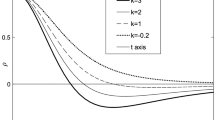Abstract
Most of the literature on spatio-temporal covariance models proposes structures that are positive in the whole domain. However, problems of physical, biological or medical nature need covariance models allowing for negative values or oscillations from positive to negative values. In this paper, we propose an easy-to-implement and interpretable class of models that admits this type of covariances. We show particular analytical examples that may be of interest in the biometrical context.
Similar content being viewed by others
References
Anderson G.D., Qiu S.-L. (1997). A monotonicity property of the gamma function. Proceedings of the American Mathematical Society 125: 3355–3362
Berg C., Forst G. (1975). Potential theory on locally compact abelian groups. New York, Springer
Berg C., Pedersen H.L. (2001). A completely monotone function related to the Gamma function. Journal of Computational and Applied Mathematics 133, 219–230
Berg C. (2004). Integral representation of some functions related to the Gamma function. Mediterranean Journal of Mathematics 1, 433–439
Bochner S. (1933). Monotone funktionen, Stieltjes integrale und harmonische analyse. Mathematische Annalen 108, 378–410
Chilès J.P., Delfiner P. (1999). Geostatistics: modelling spatial uncertainty. New York, Wiley
Christakos G. (2000). Modern spatiotemporal geostatistics. Oxford, Oxford University Press
Cressie N.A.C., Huang C. (1999). Classes of nonseparable, spatiotemporal stationary covariance functions. Journal of the American Statistical Association 94, 1330–1340
De Cesare L., Myers D.E., Posa D. (2000). Product–sum covariance for space-time modeling: an environmental application. Environmetrics 12, 11–23
De Cesare L., Myers D.E., Posa D. (2001). Estimating and modeling space-time correlation structures. Statistics and Probability Letters 51, 9–14
De Iaco S., Myers D.E., Posa D. (2001). Space-time analysis using a general product-sum model. Statistics and Probability Letters 52, 21–28
Dimitrakopoulos R., Luo X. (1994). Spatiotemporal modeling: covariances and ordinary Kriging system. In: Dimitrakopoulos R. (eds), Geostatistics for the next century (pp. 88–93). Kluwer Academic Publisher.
Gneiting T. (2002). Nonseparable, stationary covariance functions for space-time data. Journal of the American Statistical Association 97, 590–600
Janauer G.A. (2001). Is what has been measured of any direct relevance to the success of the macrophyte in its particular environment? In O. Ravera (Ed.), Scientific and legal aspects of biological monitoring in freshwater. Journal of Limnology, 60(Suppl. 1), 33–38
Ibáñez-Gual M.V., Simó A. (2004). Conditional and unconditional simulation of healthy patients’ visual fields. Biometrical Journal 46, 404–419
Levinson S.J., Beall J.M., Powers E.J., Bengtson R.D. (1984). Space-time statistics of the turbulence in a Tokamak edge plasma. Nuclear Fusion 24, 527–540
Ma C. (2002). Spatio-temporal covariance functions generated by mixtures. Mathematical Geology 34, 965–974
Ma C. (2005a). Linear combinations of space-time covariance functions and variograms. IEEE Transactions on Signal Processing 53, 857–864
Ma C. (2005b). Spatio-temporal variograms and covariance models. Advances in Applied Probability 37, 706–725
Matérn B. (1986). Spatial variation, 2nd edn. Berlin, Springer
Mitchell M., Genton M.G., Gumpertz M. (2005). Testing for separability of space-time covariances. Environmetrics 16, 819–831
Myers D., Journel A. (1990). Variograms with zonal anisotropies and non-invertible kriging systems. Mathematical Geology 22, 779–785
Pomeroy J.W., Toth B., Granger R.J., Hedstrom N.R., Essery R.L. H. (2003). Variation in surface energetics during snowmelt in a subarctic mountain catchment. Journal of Hydrometeorology 4, 702–719
Porcu E., Saura F., Mateu J. (2007). New classes of covariance and spectral density functions for spatio-temporal modelling. Stochastic Environmental Research and Risk Assessment (in press).
Rohuani S., Hall T.J. (1989). Space–time Kriging of groundwater data. In: Armstrong M. (eds), Geostatistics Vol. 2. New York, Kluwer Academic Publishers, pp. 639–651
Sasvári Z. (1994). Positive definite and definitizable functions. Berlin, Akademie Verlag
Schoenberg I.J. (1938). Metric spaces and completely monotone functions. Annals of Mathematics 39, 811–841
Shkarofsky I.P. (1968). Generalized turbulence space-correlation and wave-number spectrum-function pairs. Canadian Journal of Physics 46, 2133–2140
Vecchia A.V. (1988). Estimation and model identification for continuous spatial processes. Journal of the Royal Statistical Society B 20, 370–373
Xu Z.-W., Wu J., Huo W.-P., Wu Z.-S. (2003a). Temporal skewness of electromagnetic pulsed waves propagating through random media with embedded irregularity slab. Chinese Physics Letters 20, 370–373
Xu Z.-W., Wu J., Wu Z.-S. (2003b). Statistical temporal behaviour of pulse wave propagation through continuous random media. Waves Random Media 13, 59–73
Yaglom A.M. (1987). Correlation theory of stationary and related random functions. New York, Springer
Yakhot V., Orszag S.A., She Z.-S. (1989). Space-time correlations in turbulence - Kinematical versus dynamical effects. Physics of Fluids 1, 184–186
Author information
Authors and Affiliations
Corresponding author
Additional information
Work partially funded by grants GV04A724 (Generalitat Valenciana) and MTM2004-06231 (Spanish Ministry of Science and Education).
About this article
Cite this article
Gregori, P., Porcu, E., Mateu, J. et al. On potentially negative space time covariances obtained as sum of products of marginal ones. Ann Inst Stat Math 60, 865–882 (2008). https://doi.org/10.1007/s10463-007-0122-8
Received:
Revised:
Published:
Issue Date:
DOI: https://doi.org/10.1007/s10463-007-0122-8




